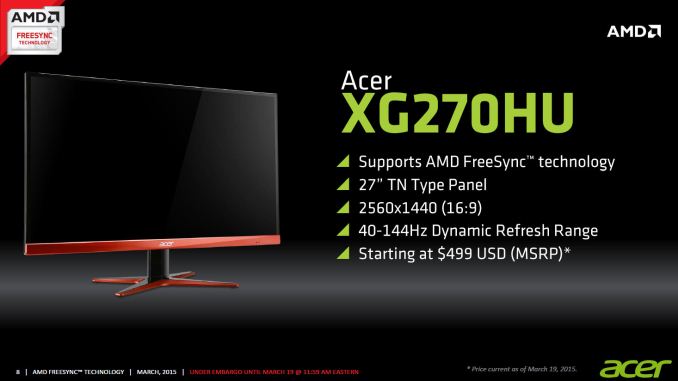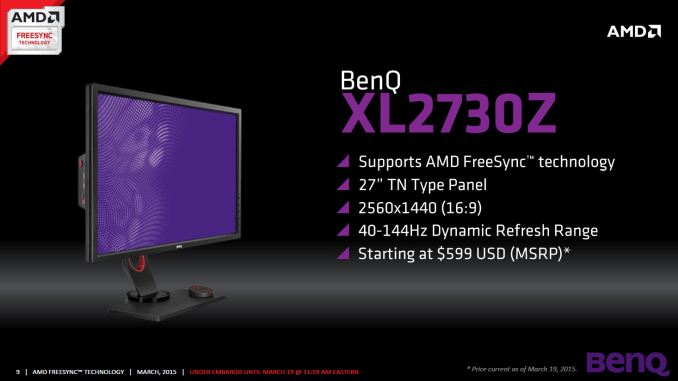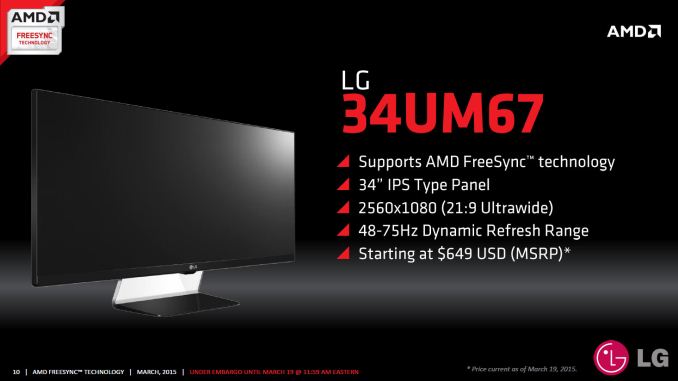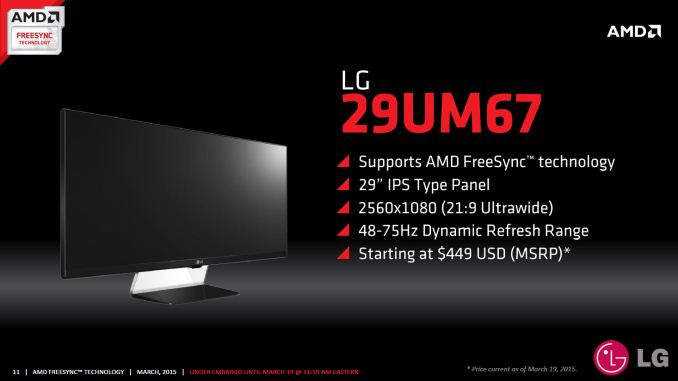The AMD FreeSync Review
by Jarred Walton on March 19, 2015 12:00 PM ESTFreeSync Displays
There are four FreeSync displays launching today, one each from Acer and BenQ, and two from LG. Besides the displays launching today, seven additional displays should show up in the coming weeks (months?). Here’s the current list of FreeSync compatible displays, with pricing where it has been disclosed.
| FreeSync Compatible Displays | ||||||
| Manufacturer | Model | Diagonal | Resolution | Refresh | Panel | Price |
| Acer | XG270HU | 27" | 2560x1440 | 40-144Hz | TN | $499 |
| BenQ | XL2730Z | 27" | 2560x1440 | 40-144Hz | TN | $599 |
| LG Electronics | 34UM67 | 34" | 2560x1080 | 48-75Hz | IPS | $649 |
| LG Electronics | 29UM67 | 29" | 2560x1080 | 48-75Hz | IPS | $449 |
| Nixeus | NX-VUE24 | 24" | 1920x1080 | 144Hz | TN | ? |
| Samsung | UE590 | 28" | 3840x2160 | 60Hz | TN | ? |
| Samsung | UE590 | 23.6" | 3840x2160 | 60Hz | TN | ? |
| Samsung | UE850 | 31.5" | 3840x2160 | 60Hz | TN? | ? |
| Samsung | UE850 | 28" | 3840x2160 | 60Hz | TN? | ? |
| Samsung | UE850 | 23.6" | 3840x2160 | 60Hz | TN? | ? |
| Viewsonic | VX2701mh | 27" | 1920x1080 | 144Hz | TN | ? |
The four displays launching today cover two primary options. For those that want higher refresh rates, Acer and BenQ have TN-based 40-144Hz displays. Both are 27” WQHD displays, so it’s quite probable that they’re using the same panel, perhaps even the same panel that we’ve seen in the ASUS ROG Swift. The two LG displays meanwhile venture out into new territory as far as adaptive refresh rates are concerned. LG has both a smaller 29” and a larger 34” 2560x1080 (UW-UXGA) display, and both sport IPS panels (technically AU Optronics' AHVA, but it's basically the same as IPS).
The other upcoming displays all appear to be using TN panels, though it's possible Samsung might offer PLS. The UE590 appears to be TN for certain, with 170/160 degree viewing angles according to DigitalTrends. The UE850 on the other hand is targeted more at imaging professionals, so PLS might be present; we'll update if we can get any confirmation of panel type.
One of the big benefits with FreeSync is going to be support for multiple video inputs – the G-SYNC displays so far are all limited to a single DisplayPort connection. The LG displays come with DisplayPort, HDMI, and DVI-D inputs (along with audio in/out), and the Acer is similarly equipped. Neither one has any USB ports, though the BenQ does have a built-in USB hub with ports on the side.
Our testing was conducted on the 34UM67, and let me just say that it’s quite the sight sitting on my desk. I’ve been bouncing between the ASUS ROG Swift and Acer XB280HK for the past several months, and both displays have their pros and cons. I like the high resolution of the Acer at times, but I have to admit that my aging eyes often struggle when running it at 4K and I have to resort to DPI scaling (which introduces other problems). The ASUS on the other hand is great with its high refresh rates, and the resolution is more readable without scaling. The big problem with both displays is that they’re TN panels, and having come from using a 30” IPS display for the past eight years that’s a pretty painful compromise.
Plopping the relatively gigantic 34UM67 on my desk is in many ways like seeing a good friend again after a long hiatus. “Dear IPS (AHVA), I’ve missed having you on my desktop. Please don’t leave me again!” For the old and decrepit folks like me, dropping to 2560x1080 on a 34” display also means reading text at 100% zoom is not a problem. But when you’re only a couple feet away, the relatively low DPI does make the pixels much more visible to the naked eye. It even has built-in speakers (though they’re not going to compete with any standalone speakers in terms of audio quality).
The launch price of $649 is pretty impressive; we’ve looked at a few other 21:9 displays in the past, and while the resolution doesn’t match LG’s 34UM95, the price is actually $50 less than the LG 34UM65’s original $699 MSRP (though it’s now being sold at $599). So at most, it looks like putting in the new technology to make a FreeSync display costs $50, and probably less than that. Anyway, we’ll have a full review of the LG 34UM67 in the coming weeks, but for now let’s return to the FreeSync discussion.
Pricing vs. G-SYNC
It certainly appears that AMD and their partners are serious about pricing FreeSync aggressively, though there aren’t direct comparisons available for some of the models. The least expensive FreeSync displays start at just $449, which matches the least expensive G-SYNC display (AOC G2460PG) on price but with generally better specs (29” 2560x1080 and IPS at 75Hz vs. 24” 1920x1080 TN at 144Hz). Looking at direct comparisons, the Acer XG270HU and BenQ XL2730Z are WQHD 144Hz panels, which pits them against the $759 ASUS ROG Swift that we recently reviewed, giving FreeSync a $160 to $260 advantage. As AMD puts it, that’s almost enough for another GPU (depending on which Radeon you’re using, of course).
Based on pricing alone, FreeSync looks poised to give G-SYNC some much needed competition. And it’s not just about the price, as there are other advantages to FreeSync that we’ll cover more on the next page. But for a moment let’s focus just on the AMD FreeSync vs. NVIDIA G-SYNC ecosystems.
Right now NVIDIA enjoys a performance advantage over AMD in terms of GPUs, and along with that they currently carry a price premium, particularly at the high end. While the R9 290X and GTX 970 are pretty evenly matched, the GTX 980 tends to lead by a decent amount in most games. Any users willing to spend $200 extra per GPU to buy a GTX 980 instead of an R9 290X might also be willing to pay $200 more for a G-SYNC compatible display. After all, it’s the only game in town for NVIDIA users right now.
AMD and other companies can support FreeSync, but until – unless! – NVIDIA supports the standard, users will be forced to choose between AMD + FreeSync or NVIDIA + G-SYNC. That’s unfortunate for any users that routinely switch between AMD and NVIDIA GPUs, though the number of people outside of hardware reviewers that regularly go back and forth is miniscule. Ideally we’d see one standard win out and the other fade away (i.e. Betamax, HD-DVD, etc.), but with a one year lead and plenty of money invested it’s unlikely NVIDIA will abandon G-SYNC any time soon.
Prices meanwhile are bound to change, as up to now there has been no competition for NVIDIA’s G-SYNC monitors. With FreeSync finally available, we expect prices for G-SYNC displays will start to come down, and in fact we’re already seeing $40-$125 off the original MSRP for most of the G-SYNC displays. Will that be enough to keep NVIDIA’s proprietary G-SYNC technology viable? Most likely, as both FreeSync and G-SYNC are gamer focused more than anything; if a gamer prefers NVIDIA, FreeSync isn’t likely to get them to switch sides. But if you don’t have any GPU preference, you’re in the market for a new gaming PC, and you’re planning on buying a new monitor to go with it, R9 290X + FreeSync could save a couple hundred dollars compared to GTX 970 + G-SYNC.
There's something else to consider with the above list of monitors as well: four currently shipping FreeSync displays exist on the official day of launch, and Samsung alone has five more FreeSync displays scheduled for release in the near future. Eleven FreeSync displays in the near term might not seem like a huge deal, but compare that with G-SYNC: even with a one year lead (more or less), NVIDIA currently only lists six displays with G-SYNC support, and the upcoming Acer XB270HU makes for seven. AMD also claims there will be 20 FreeSync compatible displays shipping by the end of the year. In terms of numbers, then, DP Adaptive Sync (and by extension FreeSync) look to be winning this war.


























350 Comments
View All Comments
eanazag - Thursday, March 19, 2015 - link
The AMD and Nvidia haters all come out of the wood work for these type articles.Intel needs to chime in. I suspect they will go the FreeSync route since it is part of the spec and there are no costs.
I understand Nvidia has some investment here. I fully expect them to support adaptive sync - at least in 5 years. They really need to do something about Phys-X. As a customer I see it as irrelevant. I know it isn't their style to open up their tech.
eddman - Thursday, March 19, 2015 - link
Not to go off-topic too much, but physx as a CPU physics engine, like havok, etc., is quite popular. There are hundreds of titles out there using it and more are coming.As for GPU physx, which is what you had in mind, yes, it'd never become widely adopted unless nvidia opens it up, and that would probably not happen, unless someone else comes up with another, open GPU accelerated physics engine.
mczak - Thursday, March 19, 2015 - link
Minor nitpick, intel's solution won't be called FreeSync - this is reserved for AMD certified solutions. Pretty sure though it's going to be technically the same, just using the adaptive sync feature of DP 1.2a.(My guess would be at some point in the future nvidia is going to follow suit, first with notebooks because gsync is more or less impossible there though even then it will be initially restricted to notebooks which drive the display from the nvidia gpu which aren't many but everything else is going to require intel to support it first. I'm quite confident they are going to do this with desktop gpus too, though I would suspect they'd continue to call it GSync. Let's face it requiring a specific nvidia gsync module in the monitor just isn't going to fly with anything but high-end gaming market whereas adaptive sync should trickle down to a lot more markets, thus imho there's no way nvidia's position on this doesn't have to change.)
anubis44 - Tuesday, March 24, 2015 - link
@eanazag: nVidia will be supporting FreeSync about 20 minutes after the first hacked nVidia driver to support FreeSync makes it onto the web, whether they like it or not.chizow - Tuesday, March 24, 2015 - link
Cool, I welcome it, one less reason to buy anything AMD related.chizow - Thursday, March 19, 2015 - link
There's no need to be disappointed honestly, Jarred just copy/pasted half of AMD's slide deck and then posted a Newegg Review. Nothing wrong with that, Newegg Reviews have their place in the world, its just unfortunate that people will take his conclusions and actually believe Freesync and G-Sync are equivalents, when there are already clear indications this is not the case.- 40 to 48 minimums are simply unacceptably low thresholds before things start falling apart, especially given many of these panels are higher than 1080p. 40 Minimum at 4K for example is DAMN hard to accomplish, in fact the recently launched Titan X can't even do it in most games. CrossFireX isn't going to be an option either until AMD fixes FreeSync + CF, if ever.
-The tearing/ghosting/blurring issues at low frame rates is significant. AMD mentioned issues with pixel decay causing problems at low refresh, but honestly, this alone shows us G-Sync is worth the premium because it is simply better. http://www.pcper.com/files/imagecache/article_max_...
Jarred has mused multiple times these panels may use the same one as the one in the Swift, so why are the FreeSync panels faling so badly at low refresh? Maybe that G-Sync module is actually doing something, like actively sync'ing with the monitor to force overdrive without breaking the kind of guesswork framesync FreeSync is using?
-Input lag? We can show AMD's slide and take their word for it without even bothering to test? High speed camera, USB input double attached to a mouse, scroll and see which one responds faster. FreeSync certainly seems to work within its supported frequency bands in preventing tearing, but that was only half of the problem related to Vsync on/off. The other trade off for Vsync ON was how much input lag this introduced.
-A better explanation of Vsync On/Off and tearing? Is this something the driver handles automatically? Is Vsync being turned on and off by the driver dynamically, similar to Nvidia's Adaptive Vsync? When it is on, does it introduce input lag?
In any case, AnandTech's Newegg Review of FreeSync is certainly a nice preview and proof of concept of FreeSync, but I wouldn't take it as more than that. I'd wait for actual reviews to cover the science of display technology that actually matter, like input lag, blurring, image retention etc that can only really be captured and quantified with equipment like high speed cameras and a sound testing methodology.
at80eighty - Thursday, March 19, 2015 - link
Waaachizow - Thursday, March 19, 2015 - link
Another disappointed AMD user I see, I agree, FreeSync certainly isn't as good as one might have hoped.at80eighty - Friday, March 20, 2015 - link
had more nvidia cards than amd; so keep trying.chizow - Friday, March 20, 2015 - link
Doubt it, but keep trying.